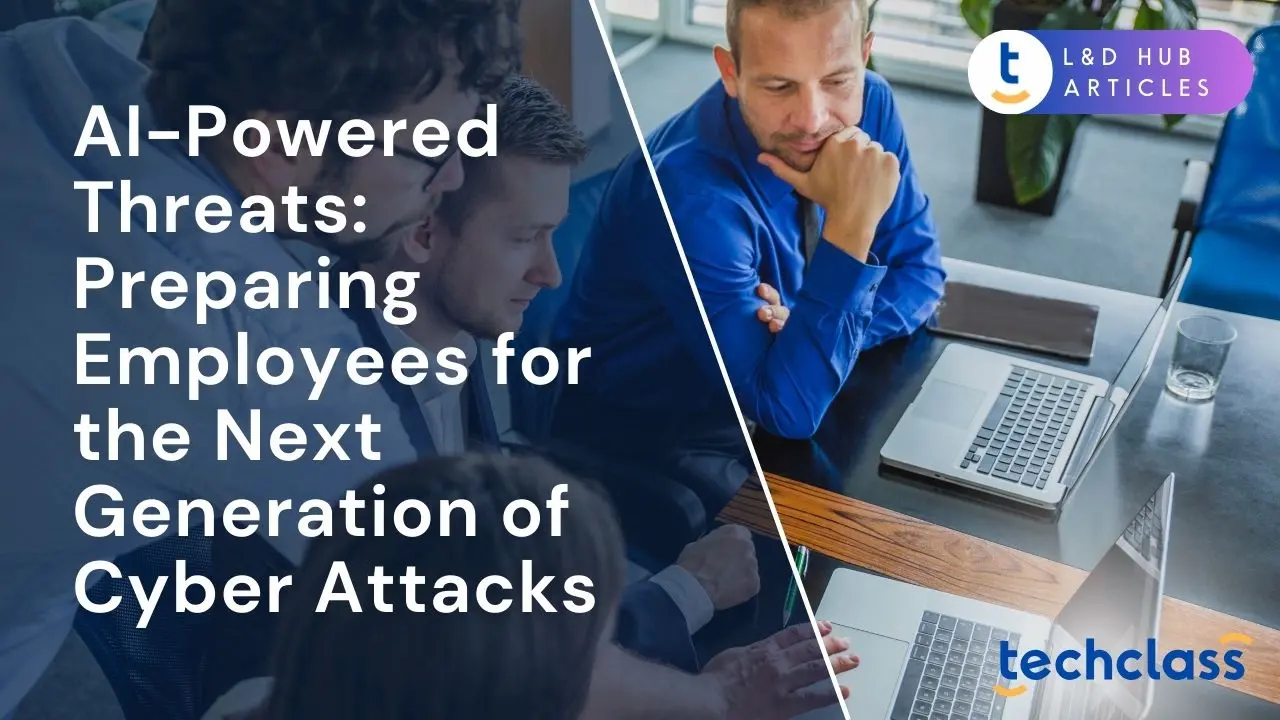
In 2019, criminals used AI-based voice “deepfake” technology to impersonate a CEO’s voice and trick an employee at a UK-based firm into transferring $243,000. The employee, believing he was following a legitimate instruction, sent funds directly to the attackers’ account. This early incident was a wake-up call: artificial intelligence (AI) has become a double-edged sword in cybersecurity. On one hand, AI is helping defenders identify threats faster, on the other, cybercriminals are weaponizing AI to launch more convincing, automated, and scalable attacks than ever before. From expertly crafted phishing emails to realistic fake voices and videos, AI-powered threats are no longer science fiction; they are today’s reality. Business leaders across industries are now asking the critical question: how do we prepare our employees to recognize and resist this next generation of cyber attacks? In this article, we’ll explore the evolving AI-driven threat landscape and practical steps to strengthen your human defenses against these emerging dangers.
AI is rapidly reshaping the cyber threat landscape, supercharging the speed and scale of attacks. Hackers can now use AI tools to create personalized phishing emails, fake websites, and even deepfake videos in a matter of seconds. This means a criminal can craft realistic scam messages and malicious code on demand, bypassing traditional detection mechanisms and targeting thousands of employees at once. The result? Breaches that used to take days or weeks to execute might now unfold within hours, in fact, incident “breakout” times (when an attacker expands access inside a network) are often under an hour in AI-fueled attacks. Security leaders around the world are taking note. In one 2025 survey, nearly 74% of cybersecurity professionals said AI-powered threats are a major challenge for their organization, and 90% expect these attacks to significantly impact them in the next couple of years. Clearly, AI isn’t just an IT issue, it’s a business risk that demands attention at the highest levels.
Equally alarming is how AI lowers the barrier to entry for cybercrime. Sophisticated hacking techniques that once required advanced skills can now be executed by almost anyone with access to AI tools. As one expert put it, malicious actors using AI have become the modern “script kiddies”, launching complex attacks with minimal effort or expertise. For example, researchers have demonstrated that freely available AI models can generate polymorphic malware (malicious software that constantly mutates its code) to evade antivirus programs. In other words, AI allows attacks to adapt in real time, staying one step ahead of traditional defenses. This unprecedented combination of speed, scale, and adaptability means organizations face an onslaught of AI-assisted threats that legacy security measures—and unprepared employees—may struggle to detect.
Phishing has long been one of the most common cyber attacks, but AI is taking it to a new level. “AI-enhanced” phishing and social engineering attacks use machine learning to craft extremely convincing fake messages. Generative AI language models (similar to ChatGPT) can mimic writing styles, correct grammar, and tailor content using details scraped from the internet about an intended victim. Instead of the clumsy, typo-filled phishing emails of the past, employees might now face emails that look personally written by a colleague or a client, complete with context that feels authentic. For instance, an AI system can scan social media and company websites to learn that Alice in HR just attended a recruiting conference, then send Alice a phishing email from a spoofed address of a new contact she met, referencing conversations that never actually happened. These messages are far harder to spot as fraudulent.
The numbers tell a sobering story. According to recent industry data, around 40% of all phishing emails targeting businesses are now generated by AI. With AI handling the heavy lifting, attackers can dramatically scale up their operations, one analysis found phishing attack volume surged by over 4,000% since the release of a popular generative AI tool in 2022. Critically, these AI-authored scams are not less effective than human-crafted ones; in a Harvard study, 60% of participants were duped by AI-generated phishing emails, a success rate comparable to emails written manually by scammers. In practical terms, AI lets bad actors launch more phishing campaigns at negligible cost (some researchers estimate AI can cut the cost of running a phishing attack by 95% while maintaining or improving its success rate). It’s a volume game: when attackers can unleash an avalanche of highly believable bait, the chance that someone in your organization will click is extremely high.
It’s not only emails. Social engineering via text messages (SMS phishing or “smishing”) and phone calls (“vishing”) is also getting an AI upgrade. Scammers can use AI voice-cloning tools to hijack the trust we place in voices. Imagine an employee gets a call that sounds exactly like the CFO, urgently requesting an unusual funds transfer, except it’s a criminal’s AI-generated voice on the line. This is precisely what happened in the deepfake voice heist mentioned earlier, and similar voice scams have been reported targeting companies around the world. AI can even simulate live chatbot conversations, impersonating tech support or vendors with frightening realism. For employees, this means the classic advice “watch for bad grammar or suspicious details” isn’t enough, an AI-crafted lure often has none of the usual red flags. Every unexpected message or call, even if it appears perfectly legitimate, may need a second look or verification through another channel. Phishing has evolved from a sporadic nuisance to a relentless, AI-automated onslaught.
A few years ago, the idea that seeing is not believing sounded like a sci-fi plot. Today it’s a daily reality, thanks to AI-generated synthetic media known as deepfakes. Deepfakes are hyper-realistic fake videos, audio, or images created by AI. In the wrong hands, they have become a dangerous tool for impersonation scams. Attackers can fabricate video calls or recordings of executives, public figures, or employees, then use those for fraud or misinformation. For example, an employee might receive what looks like a Zoom video message from their CEO instructing them to execute a confidential task (like transferring money or sharing access). Unless you’re looking very closely, you might not realize the video is completely fake, the person on screen never actually said those words. This scenario isn’t theoretical: security researchers and law enforcement have warned of cases where deepfake videos and audio were used to try to authorize financial transactions or influence business decisions.
The prevalence and impact of deepfake scams are rising sharply. In a 2024 forecast, analysts projected deepfake-based cyber attacks would increase by 50–60% year-over-year. Many of these fakes target those at the top: roughly three-quarters of deepfake fraud incidents impersonate a CEO or other C-suite executive, aiming to exploit the authority those figures hold. The financial stakes are enormous, business email compromise (BEC) and impersonation scams (now often augmented with deepfakes) have cost organizations billions. The FBI reported that impersonation schemes accounted for an estimated $12.5 billion in losses in 2023, underscoring that this is not a niche threat but a mainstream criminal technique. For HR professionals and CISOs, these developments mean that employee training must now include awareness of deepfakes. Staff should be skeptical of any unexpected directive that comes via video or voice alone. Policies may need to require verification of high-risk requests through secondary channels (for instance, if you get a video call from the CEO asking for a wire transfer, you are mandated to confirm via an in-person or phone follow-up using a known number). In an era of “digital doppelgangers,” robust verification steps are key. Seeing, or hearing, is no longer believing.
Beyond tricking people, AI is also supercharging the technical side of attacks. Cybercriminals are using AI to create smarter malware and to find vulnerabilities faster than ever. On the malware front, AI can help malicious programs continually change their characteristics, morphing their code, re-encrypting themselves, and altering behavior on the fly to evade antivirus software. This is known as polymorphic malware, and AI makes it trivial to generate endless variants of a virus or ransomware strain. Security researchers recently proved that an AI like ChatGPT can be instructed to produce mutating malicious code that standard endpoint defenses struggle to recognize. In effect, the malware rewrites itself each time it runs, staying one step ahead of signature-based detection. AI can also enable malware to make decisions (for example, lying dormant until it detects a certain high-value target, then activating), essentially adding a layer of “pseudo-intelligence” to attacks that traditionally followed static patterns. The nightmare scenario is malware that can adapt and counter defender actions in real time, potentially requiring AI-driven defenses to counter it (an emerging arms race of “AI vs AI” in cybersecurity).
Another area of concern is automated vulnerability discovery and exploitation. AI algorithms can scan code and network systems at machine speed, uncovering security gaps far faster than human pentesters or traditional scripts. This means attackers might discover and weaponize new software vulnerabilities (so-called zero-day exploits) before organizations even know they exist. For instance, an AI could rapidly analyze an organization’s public-facing applications or cloud services for weak points, and then auto-generate exploit code to pry them open. What’s more, AI chatbots have been observed assisting less-skilled hackers by generating phishing kits, malware, or even step-by-step hacking advice on demand. The upshot is that more attackers can attack more targets with greater efficiency. Small businesses, which attackers once might have overlooked, can now be attacked at scale because AI automates much of the effort. And for enterprise targets, AI helps adversaries orchestrate complex attacks (combining phishing, network intrusion, data theft, etc.) with coordination and speed that a human alone could not manage.
For organizations, defending against AI-driven technical attacks requires a combination of advanced tools and well-prepared people. Up-to-date technical controls (like next-gen antivirus, intrusion detection systems, and patch management) are vital, but so is employee vigilance. Many AI-accelerated attacks still begin by exploiting human mistakes (an employee clicking a malicious link or using an outdated, vulnerable software version). This is why a workforce that understands basic cyber hygiene and follows security best practices remains one of the best defenses, even as technology evolves. Developing that vigilance starts with comprehensive Cybersecurity Training, helping employees recognize AI-generated phishing, deepfake scams, and other emerging social engineering tactics before they lead to breaches. In the next section, we’ll examine that human element in more detail.
Despite all the high-tech hacking happening, one thing hasn’t changed: people are the gatekeepers to most organizations’ crown jewels. Attackers know this, which is why the majority of cyber incidents still involve human error or manipulation. According to Verizon’s extensive breach data, a whopping 74% of all breaches involve the “human element”, whether it’s an employee being tricked, making a mistake, or misusing their access. In other words, three out of four breaches start with a person, not a firewall. This statistic alone highlights that any cybersecurity strategy must put employees at the center. HR professionals, CISOs, and business owners need to recognize that the best technology in the world can be undermined by one untrained or unalert employee. A single click on a well-crafted phishing email or a single confidential file uploaded to a malicious fake website can open the door to a massive breach.
On the flip side, employees can also be the strongest defense. Frontline staff often serve as the “eyes and ears” of an organization’s security posture, if they know what to look for. Many attacks, especially those involving social engineering, give off subtle warnings that a savvy employee can spot and report before things escalate. For example, an employee who has been educated about deepfakes might question why a supposed urgent voice message from their CEO came via an unusual method, and double-check its authenticity. Or an employee aware of phishing tactics might notice that an email, while polished, is asking for sensitive information against company policy. In cases like these, an aware employee can interrupt the kill chain and prevent the attack from succeeding. This is why creating a security-aware culture is so critical in the age of AI threats. Every single staff member, from entry-level to executive, should understand that cyber defense is part of their job role now. It’s not just the IT department’s problem. As attacks get more automated and sophisticated, human judgment, skepticism, and diligence become all the more pivotal. In essence, your people truly are the last line of defense when all the tech layers either miss the threat or are bypassed by clever AI tricks. Investing in them is non-negotiable.
How can organizations practically prepare their workforce to handle AI-powered attacks? The key is to evolve security awareness training and policies to address these new threat tactics. Traditional annual training videos about generic phishing are no longer sufficient. Instead, companies should implement dynamic, frequent education that specifically highlights AI-driven attack scenarios. Here are some strategies to consider:
By incorporating the above measures, organizations can significantly raise their “human firewall” against AI-powered threats. Remember that training is not a one-and-done exercise. Threats and AI capabilities are evolving continuously, so security awareness must be a continuous program as well. Many companies are now moving to monthly micro-trainings or quarterly all-hands security briefings to keep staff up-to-date on the latest scams and attacker ploys. The goal is to make security awareness as routine as safety drills, an accepted, regular part of work life. When employees understand why these trainings matter (e.g. a single deepfake incident can cost the company millions or even their jobs), they are more likely to take it seriously. Cultivating this shared sense of vigilance and responsibility is perhaps the most powerful defense of all.
It’s important to note that AI isn’t only a weapon for attackers, it can be a force multiplier for defenders too. Just as criminals are adopting AI, forward-thinking security teams are deploying AI-driven tools to detect and respond to threats faster than human analysts ever could. For example, modern email security gateways now use machine learning to scan incoming messages for the subtlest signs of phishing, fraud, or malware. These AI-based filters can analyze hundreds of attributes (from writing style to header metadata) in milliseconds, flagging suspicious emails before they reach employees’ inboxes. Similarly, network monitoring systems augmented with AI can establish a baseline of “normal” user behavior and then alert on anomalies (like an account downloading an unusual amount of data at 3 AM) in real time. By sifting through mountains of data, AI can buy precious time for security teams and employees to react to an incident before it spirals out of control.
Another defensive application is using AI to train employees more effectively. Some organizations are experimenting with AI-driven training platforms that can personalize security education. For instance, if the system knows a particular employee often falls for grammar mistakes, it might present them with tailored phishing simulations that address that weakness. AI can also answer employees’ security questions on the fly (via chatbots on internal help desks), reinforcing training lessons at the moment of need. On a broader level, companies are beginning to implement AI in their incident response processes. Imagine a scenario where if an employee reports a suspected phishing email, an AI system could automatically cross-check that email against threat intelligence feeds, quarantine similar messages across all mailboxes, and even initiate password resets for the affected user, all within seconds and without waiting for a human analyst. This kind of automated, fast reaction can contain threats that would otherwise spread while waiting in a queue.
For business owners and enterprise leaders, investing in AI-enhanced security solutions is becoming as essential as investing in the workforce. Not only do AI tools help catch what humans might miss, they also alleviate the burden on security staff (who are often overwhelmed). In fact, over half of organizations have already integrated some level of AI into their security operations as of 2024. Examples of tools to consider include: AI-based endpoint detection and response (which can spot malware behavior that signature-based antivirus overlooks), user behavior analytics to detect insider threats or account takeovers, and fraud detection systems for financial transactions that learn to identify anomalies. Importantly, pairing these technologies with employee awareness creates a synergistic defense. AI might filter out 99% of phishing emails, but if a crafty one slips through to an inbox, a well-trained employee is the last guardrail to prevent disaster. Conversely, if an employee inadvertently clicks something malicious, AI monitoring may catch the resulting unusual behavior and automatically lock down the account. In summary, encourage your security and IT teams to “fight fire with fire” by leveraging AI defensively, all while continuing to shore up the human element.
The era of AI-powered cyber threats is here to stay. As we’ve seen, attackers are eagerly embracing artificial intelligence to turbocharge their exploits, but organizations can and must rise to the challenge. Building an AI-resilient organization means preparing your people just as much as upgrading your technology. HR professionals, CISOs, and business leaders should collaborate to foster a culture where cybersecurity is everyone’s responsibility and learning about new threats is part of the job. By educating employees about emerging dangers like deepfakes and AI-generated phishing, and by equipping them with clear processes to verify unusual requests, companies can greatly reduce the risk of falling victim to these schemes. At the same time, leveraging advanced AI-driven defenses can provide a safety net and enable your security team to act at machine speed when incidents occur.
In the face of rapidly evolving attacks, complacency is the enemy. The organizations that thrive in this new landscape will be those that stay proactive, continuously updating training curricula, simulating cutting-edge attack techniques, and investing in intelligent security systems. It’s an ongoing arms race of AI vs AI, and preparedness is the price of survival. The good news is that awareness and readiness can tilt the odds back in our favor. When employees remain vigilant and informed, and when technology and people reinforce each other’s strengths, even the most sophisticated AI-powered attack can be thwarted. Cyber threats may be getting smarter, but so are we. By building a workforce that is savvy to AI-driven tricks and a defense strategy that harnesses AI for good, any enterprise can confidently face the next generation of cyber attacks. In this new chapter of cybersecurity, human intuition and AI innovation together form the best defense. Stay smart, stay prepared, and you’ll ensure that your organization is ready for whatever the future holds.
AI-powered attacks are faster, more personalized, and scalable, enabling criminals to automate complex attacks such as phishing and malware, which can bypass traditional defenses.
Deepfakes are AI-generated videos or audio used to impersonate executives or other individuals, often for fraud or misinformation, such as instructing employees to execute fraudulent transactions.
Employees should look for signs like personalized messages, highly polished grammar, and context-specific details. Verification through secondary channels and skepticism is key in spotting these attacks.
Organizations should provide dynamic training, including real-life examples of AI-generated phishing emails, deepfake videos, and voice calls, as well as frequent simulated attacks for practice.
Yes, AI tools can enhance cyber defense by detecting threats faster, automating responses, and personalizing employee training, helping organizations stay ahead of AI-powered cybercriminals.


